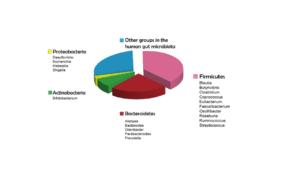
We constantly talk about the microbiota and the multiple benefits it has on our health but .... have we stopped to know what exactly is the microbiota?
The gut microbiota is a collection of different kingdoms such as bacteria, viruses, fungi, yeasts, parasites and Archaea that inhabit in symbiosis in the human body. ¹,²
As we all know, the microbiota is key to maintaining a good state of health since it influences the development of the immune system and the homeostasis of the individual.
The composition of the microbiota depends mainly on factors external to the individual, such as diet, lifestyle, medications, etc., and is therefore different for each individual.¹,²².
The native flora is that which is acquired during the first year of life and is influenced by the type of birth (vaginal delivery or cesarean section) as well as breastfeeding. While the transient flora is that which intermittently colonizes the intestine¹,².
The intestine measures approximately 8 meters and its mucosal surface area is 300 - 400 m².
The main families that colonize it are:
- Firmicutes: 30-60%.
- Bacteroides 9-40% Bacteroides
- Actinobacteria: 1-13%.
To a lesser extent: proteobacteria, yeasts, viruses, phages and protists¹,².

All these microorganisms constitute between 1 and 2 kg of a person's total weight.
How are the different microorganisms distributed in our body? ² ²
- Stomach and duodenum: 10¹ and 10³ CFU/mL
- Jejunum: 10^4 and 10^7 CFU/mL
- Ileum: 10^7 and 10^8 CFU/mL
- Large intestine: 10¹¹¹ and 10¹² CFU/ml.
The large intestine, from the cecum to the rectum, contains more than 500 genera of bacteria.
What are the main functions?
1- Metabolic function:
- Promotes food digestion and nutrient absorption
- Participation in the synthesis of metabolites such as short-chain fatty acids or vitamins.
2- Barrier function:
- Defense against pathogenic microorganisms
- Production of little mucosal protectant: promotes permeability to pathogens
3- Defense function:
- Development and activation of the intestinal immune system
4- Maintenance function:
- Maintenance of the intestinal mucosa and the lumen of the intestine free of debris.
- Mucus production.
1. ALVAREZ, Julia, et al. Gut microbes and health. Gastroenterology and Hepatology (English Edition), 2021, vol. 44, no 7, p. 519-535.
2. DUQUE, Mario Gómez; ACERO, Fanny. Composition and functions of the intestinal bacterial flora. Revista Repertorio de Medicina y Cirugía, 2011, vol. 20, no 2, p. 74-82.
Learn more about the importance of the microbiota at https://isomed.com/microbiomas-para-la-vida-dia-mundial-del-microbioma/.